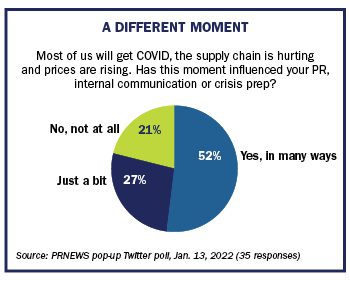
It’s not difficult to argue the U.S. is in an unusual moment.
First, nearly all of us will contract COVID eventually, Dr. Anthony Fauci, President Joe Biden’s chief medical advisor, said Jan. 12. And while some epidemiologists believe the omicron variant signals the pandemic’s end, others, such as Dr. Michael Osterholm, director of the Center for Infectious Disease Research and Policy at the University of MN and a member of Biden’s COVID-19 advisory board, are not sure. As such, Osterholm said two weeks ago the country should prepare for omicron to recede and for another variant or sub-variant to emerge.
And add rising inflation and supply chain disruptions to the somewhat bleak picture.
“People go into the grocery store and they’re not seeing bread on the shelves. It makes them nervous,” says Don Smialowicz, the newly minted CEO at HudsonLake in suburban Washington, D.C.
Viewing this moment from a PR pro’s perspective, the question arises: Have the strategies and tactics of PR changed as a result of this unusual moment? Should they?
After all, some argue that before the pandemic PR pros were supposed to read the room, keeping tabs on customers, competitors and the rest of the zeitgeist. This allowed them to make course corrections to communication efforts as needed.
Change or Not?
As such, this argument goes, the PR pro is doing what she has done for years: communicating, pitching, advising and raising awareness, all based on the state of play and with an eye toward the future.
True, today’s conditions are different than they were before the pandemic, yet the PR’s pro’s job essentially is the same.
Along with a quick poll about these questions (see graphic), PRNEWS asked a group of communicators for their view. In contrast to the poll’s results–nearly half the respondents said PR is unchanged or changed only slightly–there was little equivocation from those we interviewed.
The combination of Covid, inflation and supply chain problems, but mostly the pandemic and its attendant issues, has changed conditions so much that, “If you haven’t adjusted your [communication] approach, you’re missing something,” Steve Cody, founder & CEO of Peppercomm, argues.
Referring to internal communication, Smialowicz says, “You can’t take the standard approach now in terms of cadence…you have to change…people need reassurance” at this time.
Similarly, Meredith L. Eaton, N. American head for Red Lorry Yellow Lorry, believes the rise of mis- and disinformation, in part around Covid, has put a premium on accuracy in communication. The public, she says, has less tolerance now for conflicting messages. This aversion is due in part to the quick pace of multiple messages about Covid, says Eaton and Inspire PR Group chief Hinda Mitchell.
Similarly, speed, partly from Covid, has prompted changes, Mitchell says. “It’s impossible to create a year-long communication strategy and think it’s in cement.”
Her advice includes constant pop-up research about stakeholders’ state of mind. Adds Cody, “You have to be in crisis mode every day…you must constantly monitor audiences…or you could be inviting a reputation issue.”
Similarly, Cody and Mitchell say communicators must realize they may have to change plans rapidly. “Move swiftly but carefully,” Mitchell says. “It’s very easy today for companies to step in it.”
Reading the Room
Accordingly, Mitchell says the importance of PR pros reading the room has risen “exponentially” in this omni-crisis moment. “Your customers can change as fast as [Covid], your industry and world events,” Mitchell says.
In addition, Smialowicz notes something the pandemic accelerated. “You have to embrace hybrid work and flexibility now…still, don’t lose sight of the value of in-person, face-to-face interaction.”
The influence of speed, which Mitchell mentioned above, is the main factor for April Mason, who heads Violet PR, a small firm in NJ. Specifically, Mason notes the speedy news cycle the pandemic has, in part, caused. With news about COVID-19 and its variants changing, sometimes hourly, media relations pros like Mason have adjusted or become irrelevant, she says.
For example, Mason often pitches stories that work alongside the day’s breaking news. Covid’s constant updates means she is looking for new angles at a fast pace. “What’s relevant today as a pitch, might not be tomorrow, or even a few hours from now,” depending on Covid developments, she says.
Expiration Date
In addition, as the length of a pitch’s shelf life has declined in this climate, Mason advises that “your executive is ready to speak with a reporter” the day you pitch.
While it depends on the pitcher and the executive, for Mason, pitching a story “a month out just doesn’t happen very much anymore.” Enterprise stories also are occurring less frequently, she says.
Also gone, she says, are desk-side appointments. “You’d bring a CEO or a political leader to meet with an editor and reporter for a wide-ranging conversation.” A few weeks later, the reporter called and indicated what topics could result in a story, she says.
The pandemic also sped the reduction in newsroom size, Mason argues. As a result, pitchers and executives interviewing with reporters best be succinct, she says. Her counsel for interviewees is to have not more than three talking points.
“Reporters don’t have time for executives who digress,” Mason adds. Several reporters abruptly ended several interviews she arranged. CEOs “can’t be offended by this. You explain to them that if you want coverage you have to work in this [sped-up] structure.”
Good News
It’s not all bad news, however. Mason doubled revenue and staff in 2021. “A lot of [PR pros] had a good year,” she says. Again, the pandemic offered conditions that led to a resurgence in her business.
“We lost 30 percent of our revenue during lockdown” at the start of the pandemic, she recalls. That allowed Mason time to “do more publicity for the firm, answer more RFPs and create more content,” including thought-leadership essays. With newsrooms straining, media is ripe for submitted essays, she says.
Another important factor for Mason was the rise in Covid-related federal and government spending. Much of her business is centered on government and contractors.
Though Mason doesn’t refer to the oft-mentioned demand for internal and external communication stemming from the pandemic, Smialowicz does. His bailiwick, internal communication, is top of mind for many CEOs today, or should be, owing, in part to the Great Resignation. “If you think you’re communicating enough with staff, think again” he says.
His prescription calls for adapting tenets of crisis communication. You must be transparent about what you know and really transparent about what you don’t, he says.
“And you have to make it continuously clear where people can look for stability. Ultimately, what people need is to trust…there’s so much information and opinion out there…people need to trust the leadership of their organization.”
Though, as mentioned above, Smialowicz advocates an increase in the cadence of internal communication for many companies–he urges periodic updates, “people don’t want a void”– this rise means communicators must also raise their game to engage employees.
New Routes for Internal Communication
While a consistent message–‘You are valued, we care about you, the company is stable’– is key, so is finding new and innovative ways to engage employees. It’s a delicate dance–communicate more but don’t do it so often that employees are overwhelmed.
As such, he counsels a mix of top-down and bottom-up communication.
For top-down, he suggests CEOs demonstrate authenticity and humanity through a certain amount of vulnerability. “There was so much uncertainty with the pandemic and social unrest…leaders have to admit ‘I don’t what’s ahead, I’m not exactly sure where we’re going…but I know we’re going to figure it out together.’” If the CEO is uncomfortable doing this, find another senior executive who can, he says.
Adds Mitchell, tone of voice in communication has risen in both internal and external messaging as people are “hungry” for normal. “A few of the good things to come from the pandemic are empathetic communication and the fact that more companies realize they have to engage more humanely with employees and other stakeholders.”
Obviously, this is good for PR. Companies, she says, realize they must engage people (internally and customers) where “their heads are…it’s become clear to the C-suite that PR is good at reading the room and was using digital communication before the pandemic…all this has helped PR gain a seat at the table,” Mitchell says.
Similarly, Eaton emphasizes an increase in humanizing internal and external messages. “People are working more, with full-time jobs and perhaps caring for children…so they crave a distraction,” she says. Communicators, she continues, can provide that distraction at work with storytelling content that features people overcoming odds and succeeding. “You want to be more than a vendor producing products,” she says.
With bottom-up communication, ensuring employees have an outlet where they can be heard is essential, Smialowicz says. One-on-ones are his preference, if possible, along with “brief” surveys and focus groups. “And after you’ve listened to employees, act and communicate your findings and what you’re doing.”

